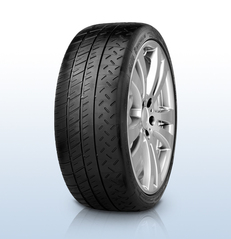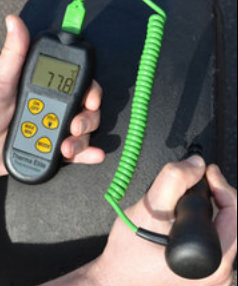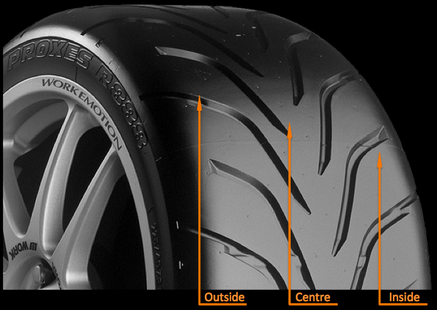Tyre Management
Because tyres are the only thing in contact with the track, it's essential they're in good condition and that you manage them to maximise the grip and balance during braking, accelerating and cornering. To do that you need to understand the difference between road tyres, track tyres and all the variables at work.
Caution: If your tyres are in poor condition or you don't manage them correctly you could potentially put yourself and others at risk.
Caution: If your tyres are in poor condition or you don't manage them correctly you could potentially put yourself and others at risk.
Heat
- Driving on a race circuit will work your tyres much harder than on the road generating significant heat. As the tyres heat up the pressures can increase quite dramatically which stiffens the tyre and increases the temperature yet again so it's important you bleed some air out to restore the right working pressures. With road tyres it's also very important to keep them within their operating temperature range by limiting the length of each session or strategic use of cool down laps during and at the end of each session.
- Tyre pressure is a compromise between the footprint of the tyre on the tarmac and the amount of suspension in the side wall. The optimum hot tyre pressures are heavily influenced by the vehicle weight, driving style and weather conditions but regardless, grip levels and handling characteristics of the car will change during the heat up process.
- Under inflation will allow the sidewalls to flex too much causing vague handling, slow turn-in and possible damage to the tyre with chronic shoulder wear through rolling over on cornering.
- Over inflation will reduce the width of the tyre in contact with the road reducing grip and driver feedback leading to possible abnormal loading and possible overheating in the centre of the tread pattern. Good for fuel efficiency on the motorway but not the race track!
- The tyre load rating is part of the service specification of a tyre (e.g. 295/30 R18 94Y) and relates to the stiffness of the sidewall which acts as a very important extension of the suspension and a baseline for tyre pressures. If the load rating is too low the tyre will not support the car during cornering leading to poor handling and could even damage your wheel rims. If you cannot get the tyre to perform within the tyre pressure guidelines below you should check the load rating.
- There can be quite a lot of debris on track, especially rubber. Avoid driving over debris from anyone else's incident, check your tyres throughout the day and keep the dust caps on to prevent dirt getting into the tyre valves.
Pressure Management - Road tyres
If you're not sure what pressures to use, a good starting point is 2-4 psi below the manufacturers recommended pressures with a target hot pressure of 2-4 psi above. Here's a simple routine for building up your tyre pressures and temperatures:
If you're not sure what pressures to use, a good starting point is 2-4 psi below the manufacturers recommended pressures with a target hot pressure of 2-4 psi above. Here's a simple routine for building up your tyre pressures and temperatures:
- Before venturing onto the circuit set your pressures 2-4 psi below the manufacturers standard cold road pressures (Ignore if cold or wet).
- During the first session the temperatures and pressures will increase. Come back into the pits after 10-15 minutes or if the tyres start to squeal.
- Check the pressures and adjust to your target pressure.
- After your second session the tyres will have probably stabilised, check and adjust again if necessary.
- With stable tyre temperatures you can now look to make small pressure adjustments to remove any understeer or oversteer.
|
Track Tyre Pressure Guidelines
For your first time on track tyres use manufacturers pressures as a start point and work from there.
|
Tune out understeer and oversteer
Tyre pressure adjustment can't eliminate major handling issues but can be used for fine tuning. Assuming your pressures are in the zone, adjust the pressures according to the table below to subtly tune the front to rear balance for cornering. Perform a one incremental change at a time so you know how each change influences the handling.
* Whichever is more appropriate to keep pressures within the guidelines above
|
|
Each tyre should have 3 temperature readings taken as soon as the car is stationary in the pits for best results. These readings are about 25mm in from the inside and outside edges of the tyre and the centre. The results should be written down for reference to record the effect of any adjustments.
Check with your tyre manufacturer but for most you should be aiming for a maximum temperature variation across the tyre of 10 °C and maximum pressure of 40psi when hot. Note that some symptoms have multiple diagnosis, one or more may apply. Sometimes multiple symptoms appear simultaneously. Making one change at a time is advisable to best evaluate the impact of the change. |
|
Results
Centre hotter than Inside/Outside Inside/Outside hotter than Centre Inside hotter than Outside Outside hotter than Inside Temperatures below optimal range Temperatures above optimal range Front tyres hotter than rear - Understeer |
Diagnosis
Pressure too high, lower 1 psi/2.5 °C Pressure too low, add 1 psi/2.5 °C Too much negative camber Too little negative camber, too much toe-in Pressure too high, tyres too wide, suspension/rollbars too stiff Pressures too low, tyres too narrow, suspension/rollbars too soft FRONT: pressure too low, tyres too narrow, suspension/rollbars too stiff REAR: pressure too high, tyres too wide, suspension/rollbars too soft |






